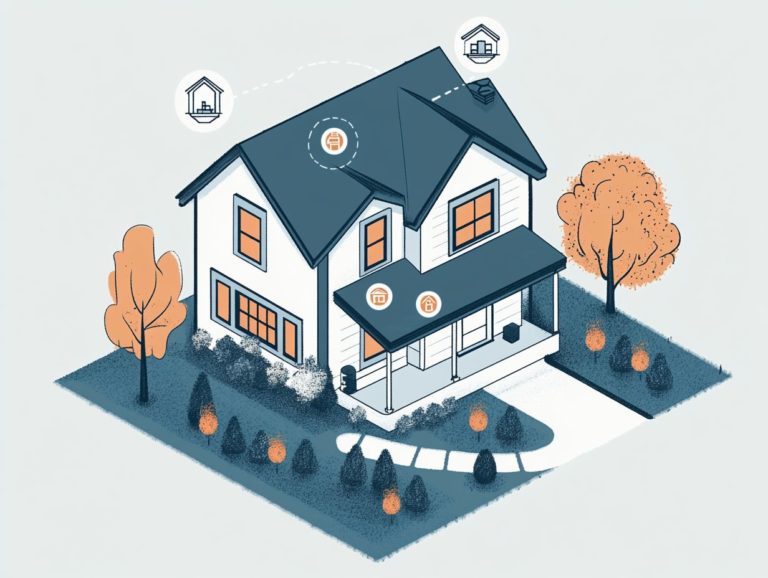Types of Home Insurance for Multi-Family Units
Navigating the world of multi-family units can feel like a labyrinth. This is particularly true when it comes to grasping the diverse array of home insurance options available to you.
From individual unit coverage to comprehensive master policies, each choice offers its own unique advantages. As the demand for multi-family living continues to rise, the necessity for customized insurance solutions tailored to your specific needs also increases.
This guide provides clear definitions, emphasizes the importance of insurance, and outlines key factors to consider when selecting the ideal coverage for your multi-family property.
Uncover how to safeguard your investment and ensure peace of mind for both you and your tenants.
Contents
- Key Takeaways:
- Understanding Multi-Family Units
- Importance of Home Insurance for Multi-Family Units
- Types of Home Insurance for Multi-Family Units
- Key Factors for Choosing Multi-Family Home Insurance
- Frequently Asked Questions
- What types of home insurance should I consider for multi-family units?
- What does landlord insurance cover for multi-family units?
- What does condominium insurance cover for multi-family units?
- What does renters insurance cover for multi-family units?
- Do apartment buildings need different home insurance than single-family homes?
- Can you have various types of home insurance for an apartment building?
Key Takeaways:

- Multi-family units are defined as properties with more than one living unit, such as duplexes, townhouses, and apartment buildings.
- Home insurance is your shield against risks, protecting multi-family units from potential hazards while providing financial security for both landlords and tenants.
- There are three main types of home insurance for multi-family units: individual unit insurance, master policy insurance, and umbrella insurance. Each offers different levels of coverage and protection.
Understanding Multi-Family Units
Understanding multi-family units is crucial, whether you’re a property owner or a tenant. These structures offer housing options for a wide variety of individuals and families.
Typically, multi-family units consist of residential buildings that house multiple separate units, like apartments or condominiums. They can vary greatly in size and design.
Knowing the specifics of multi-family properties helps you understand their unique needs. This includes specialized insurance options and risk management strategies to protect the property and its occupants.
As the demand for multi-family housing continues to rise, it’s important to recognize their role in city planning.
Definition and Types of Multi-Family Units
Multi-family units refer to residential buildings designed to accommodate multiple families or tenants under one roof. These properties come in various forms, including apartments, condominiums, and multi-family homes, each catering to different lifestyles and preferences.
Apartments typically serve as rental units that offer convenience and low maintenance. These are particularly attractive to young professionals and families in search of affordable housing.
Condominiums appeal to those who desire ownership without the burdens that come with maintaining a single-family home. This often attracts retirees and downsizers looking for a simpler lifestyle.
Multi-family homes provide distinct living spaces while sharing resources like yards or utilities. This makes them ideal for larger families or groups of friends seeking a community-oriented living environment.
Each type presents unique benefits tailored to the needs of its residents, solidifying multi-family units as a versatile option in today s housing market.
Importance of Home Insurance for Multi-Family Units
Home insurance is essential for protecting multi-family units against various risks, such as property damage, tenant injuries, and potential loss of income from unforeseen events. The right insurance coverage secures the physical structure and provides financial stability for you as a property owner, while offering peace of mind to your tenants.
Given the unique challenges that come with managing multi-family properties like higher tenant turnover and the complexities of communal living comprehensive insurance policies are vital.
Understanding the significance of liability insurance, loss history, and coverage limits can greatly enhance your risk management strategies. This ensures you re well-equipped to handle any potential issues.
Explore your insurance options today to protect your investment!
Why Home Insurance is Necessary
Home insurance is essential for multifamily properties, offering protection against potential liabilities such as property damage and tenant injuries.
In a bustling urban landscape where multifamily residences are increasingly prevalent, the risks tied to these properties can be substantial. From unexpected natural disasters to unforeseen accidents in shared spaces, property owners face numerous threats that could jeopardize their financial investments.
Creating a safe living environment isn t just a legal responsibility; it also helps build a positive reputation among tenants. This can lead to reduced vacancies and the ability to command higher rents.
By securing complete protection, you can defend yourself against lawsuits arising from tenant injuries and ensure coverage for both the building and its occupants. This contributes to a stable and thriving rental community.
Types of Home Insurance for Multi-Family Units

Understanding the various types of home insurance available for multi-family units is crucial for property owners to select the right coverage tailored to their specific needs. For more information, check out this guide on understanding the differences in home insurance types.
You’ll find several insurance options at your disposal, such as:
- Individual unit insurance, which covers each unit separately.
- Master policy insurance, which protects the entire building as a single entity.
- Umbrella insurance, which offers additional liability coverage, safeguarding you from unexpected lawsuits or claims that could surpass standard policy limits.
Each type of insurance serves a distinct purpose, making it essential for you to assess your unique circumstances when selecting the appropriate policies.
Individual Unit Insurance
Individual unit insurance is crafted to protect your interests as a tenant in multi-family properties.
This tailored coverage acts as a safety net for your personal belongings, ensuring that your electronics, furniture, and clothing are shielded from unexpected events like theft, fire, or water damage.
It also protects you from potential liability claims that could arise if someone is injured within your unit. It s not merely about safeguarding your possessions; it s about offering you peace of mind.
With affordable premiums and a range of complete protection options, having this insurance can significantly ease your financial burden and enhance your sense of security while living in a communal environment.
Master Policy Insurance
Master policy insurance provides coverage for the overall structure of multi-family properties, streamlining the insurance process for property owners.
This type of insurance is crucial because it not only protects the building itself but also the shared areas that all tenants depend on, such as hallways, stairwells, and recreational facilities.
With a master policy in place, you ensure that you’re shielded from costly repairs and liabilities that may arise from incidents in these common spaces. It also simplifies insurance responsibilities for individual unit owners, who often have the option to obtain their own policies for personal belongings while the master policy addresses overarching structural concerns.
This approach creates stability and peace of mind for everyone involved, fostering a harmonious environment in your property.
Umbrella Insurance
Umbrella insurance offers an invaluable layer of additional liability coverage for property owners of multi-family units, enhancing existing policies significantly. This specialized form of insurance serves as a protective barrier, covering unexpected claims that may exceed traditional policy limits, such as those stemming from accidents or injuries on the property.
As a landlord, this extra protection is paramount; it safeguards your financial interests and brings you peace of mind. By complementing your standard homeowners or renters insurance, umbrella coverage ensures that even in dire situations like substantial legal judgments you are not left vulnerable.
This layered approach to risk management is essential in today s unpredictable landscape.
Don t wait! Protect your investment today by consulting a professional for home insurance advice.
Key Factors for Choosing Multi-Family Home Insurance
Choosing home insurance for multi-family units? Keep these critical factors in mind for great coverage and savings, and consider understanding homeowners insurance types to ensure you make the best choice.
Consider the building s condition, risks from tenant injuries, and specific coverage needs.
Understanding different insurance costs helps you make informed choices.
By carefully evaluating these key aspects, you can effectively manage risks while securing comprehensive insurance protection for your property.
Location and Building Structure

The location and building structure of your multi-family property play a crucial role in the insurance policy options available to you as a property owner.
Proximity to flood zones, earthquake-prone areas, and hurricane paths can significantly impact your coverage options and premiums. For instance, if your property is in a flood-prone region, you might need additional flood insurance or face higher deductibles. Similarly, properties in wildfire-prone areas could see steep premiums due to increased risk.
Insurers evaluate these geographical elements to assess hazards, which shapes both the cost and depth of coverage you can access. By grasping these nuances, you can make informed decisions when selecting the best insurance plans to protect your investment.
Number of Units and Tenants
The number of units and tenants in a multi-family property can significantly influence your insurance coverage and premiums.
Higher tenant turnover can be viewed as an increased risk by insurers, leading to higher premiums or stricter coverage conditions. A property with many units may seem less stable, especially if many are frequently vacated. This perceived instability can prompt insurance carriers to reassess their risk evaluations, considering factors like property maintenance and tenant profiles.
You may find yourself navigating an intricate insurance landscape where the quality of your tenants and the stability of occupancy levels impact your overall coverage costs.
Insurance Coverage and Cost
As a property owner, grasping how coverage relates to costs is essential for finding the right policy for your multi-family units.
In today s competitive insurance market, evaluate your options carefully to find the perfect balance between comprehensive coverage and manageable premiums. Analyzing various policies’ financial implications helps secure adequate protection against potential risks while avoiding unnecessary expenses.
For example, consider factors such as property value, tenant occupancy rates, and specific coverage limits to effectively protect your multi-family dwellings.
This thoughtful approach enables you to navigate the intricate landscape of insurance choices, helping you make informed decisions that align with your financial goals.
Frequently Asked Questions
What types of home insurance should I consider for multi-family units?
There are three main types: landlord insurance, condominium insurance, and renters insurance.
What does landlord insurance cover for multi-family units?

Landlord insurance typically covers the building’s physical structure, liability protection for tenant injuries, and loss of rental income in the event of a covered loss.
What does condominium insurance cover for multi-family units?
Condominium insurance covers the individual unit owner’s personal belongings, liability protection, and any upgrades or improvements made to the unit.
What does renters insurance cover for multi-family units?
Renters insurance covers the tenant’s personal belongings, liability protection, and additional living expenses if the unit becomes uninhabitable due to a covered loss.
Do apartment buildings need different home insurance than single-family homes?
Yes, apartment buildings usually need different home insurance because multiple tenants share the space. This setup brings unique risks that single-family homes don t have.
Can you have various types of home insurance for an apartment building?
You can have different types of home insurance for an apartment building. For instance, the building owner may need landlord insurance, which covers property damage and liability, while tenants should get renters insurance to cover their personal belongings.






